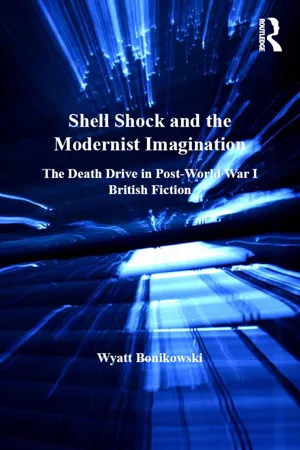
Shell Shock and the Modernist Imagination
The Death Drive in Post-World War I British Fiction
- 200 pages
- English
- ePUB (mobile friendly)
- Available on iOS & Android
Shell Shock and the Modernist Imagination
The Death Drive in Post-World War I British Fiction
About This Book
Looking closely at both case histories of shell shock and Modernist novels by Ford Madox Ford, Rebecca West, and Virginia Woolf, Wyatt Bonikowski shows how the figure of the shell-shocked soldier and the symptoms of war trauma were transformed by the literary imagination. Situating his study with respect to Freud's concept of the death drive, Bonikowski reads the repetitive symptoms of shell-shocked soldiers as a resistance to representation and narrative. In making this resistance part of their narratives, Ford, West, and Woolf broaden our understanding of the traumatic effects of war, exploring the possibility of a connection between the trauma of war and the trauma of sexuality. Parade's End, The Return of the Soldier, and Mrs. Dalloway are all structured around the relationship between the soldier who returns from war and the women who receive him, but these novels offer no prospect for the healing effects of the union between men and women. Instead, the novels underscore the divisions within the home and the self, drawing on the traumatic effects of shell shock to explore the link between the public events of history and the intimate traumas of the relations between self and other.
Frequently asked questions
Information
Chapter 1Introduction: Shell Shock and the Traces of War
Silence after War
For the first day or two on leave one would make serious efforts at communicating with the other sort of human being. Sometimes the efforts almost seemed to be meeting with success, there was quite a sympathetic atmosphere. Then some extraordinary and irrelevant question-assertion—“But surely our men are much braver than the Germans?”—would shatter it. It wasn't a question of anyone's being brave; it was a question of trying to communicate the incommunicable. There was no ratio between the two races of men—those, I mean, in the line and those who had never touched it. I say “touched” because it was so physically penetrating. (363)
Table of contents
- Cover Page
- Half Title Page
- Dedication
- Title Page
- Copyright Page
- Table of Contents
- Acknowledgments
- 1 Introduction: Shell Shock and the Traces of War
- 2 The Invisible Wound: Shell Shock and Psychoanalysis
- 3 Transports of a Wartime Impressionism: Ford Madox Ford’s Parade’s End
- 4 The “Passion of Exile”: Rebecca West’s The Return of the Soldier
- 5 “Death was an attempt to communicate”: Virginia Woolf’s Mrs. Dalloway
- 6 Conclusion: The Ethics and Aesthetics of the Death Drive
- Bibliography
- Index